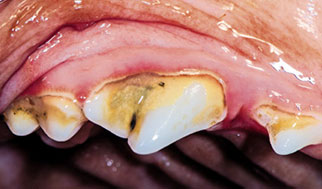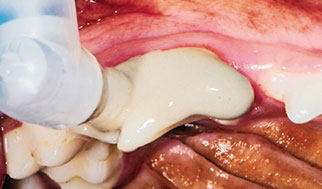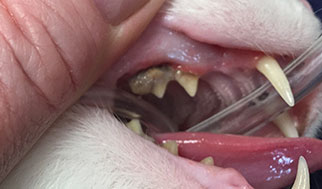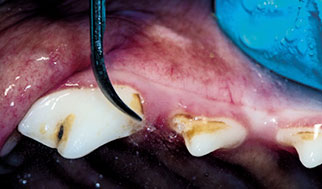Therapeutic Dentistry
The mouth has a huge impact on the overall health of your pet.
Dental disease not only has an impact on the mouth, in terms of tooth loss and tooth pain; it affects the entire body. Infection in the mouth is a battle that the immune system is continuously having to expend resources to fight. And bacteria from the mouth can make it into the bloodstream, to colonize other parts of the body.


The most common sites for dental bacteria to cause problems are:
- Heart valves (bacterial endocarditis)
- Lungs (bacterial embolism)
- The “filter” organs, the lungs and kidneys, where abscesses can form.
Our comprehensive dental health program begins with every exam we see your pet for – we will check the state of your pet’s teeth and gums, and endeavour to stop any problems before they get far.
Preventive care can include:
- Tooth-brushing – the absolute gold standard of care! We will teach you how train your pet to accept this odd thing their human is doing to them.
- “Scrubbers” – dental diets or dental treats. NOTE: these affect the teeth the pet chews with. That means there is not so much effect for the front teeth and the fangs; and if your pet is a “one-sided chewer”, then only one side may get cleaned.
- Water additives – so that each time your pet takes a drink, he also takes some action against the build-up of mouth bacteria.
Sooner or later, though, even in a well-maintained mouth, the plaque and tartar can start to pull ahead of our efforts.


At this stage, we step into therapeutic care of the mouth:
- COHAT – this stands for Complete Oral Health Assessment and Treatment. This is done under general anaesthesia – you cannot properly get into a cat or dog’s mouth, or clean down into gum pockets, without anaesthesia. The full extent of the mouth is examined, and the pockets around the teeth are probed and checked for depth. Then the tartar is removed, the teeth are cleaned with the ultrasonic scaler, and the tooth surfaces are polished.
- Dental radiography – the oral exam shows us the crowns of the teeth, but we can not see what is going on with the roots, and in the bony sockets. Dental x-rays let us pick up on problems before they are visible from above.
- Dental Surgery – this includes:
- Extractions – if teeth are loose (and sometimes it can be one root that is bad in a 3-rooted tooth) then they should be removed. If the dental x-ray shows that even though a tooth is not obviously loose yet, its socket is so diseased it will be soon, then it too should be removed. All extractions are performed with local anaesthesia (“freezing”) in place. Our high speed dental drill helps to keep these procedures as non-traumatic as possible.
- Gum surgery – this could involve removal of proliferative gum tissue that negatively impacts the teeth (epulis), removal and biopsy of masses or tumours, or removal of the outer wall of a deep gum pocket that traps food and plaque. Gum surgery may also be done to close the gums over a non-infected tooth socket after a tooth has been extracted.
Our goal is a more comfortable mouth for your pet, a longer and healthier life… and of course better smelling doggie kisses and kitty bumps!

